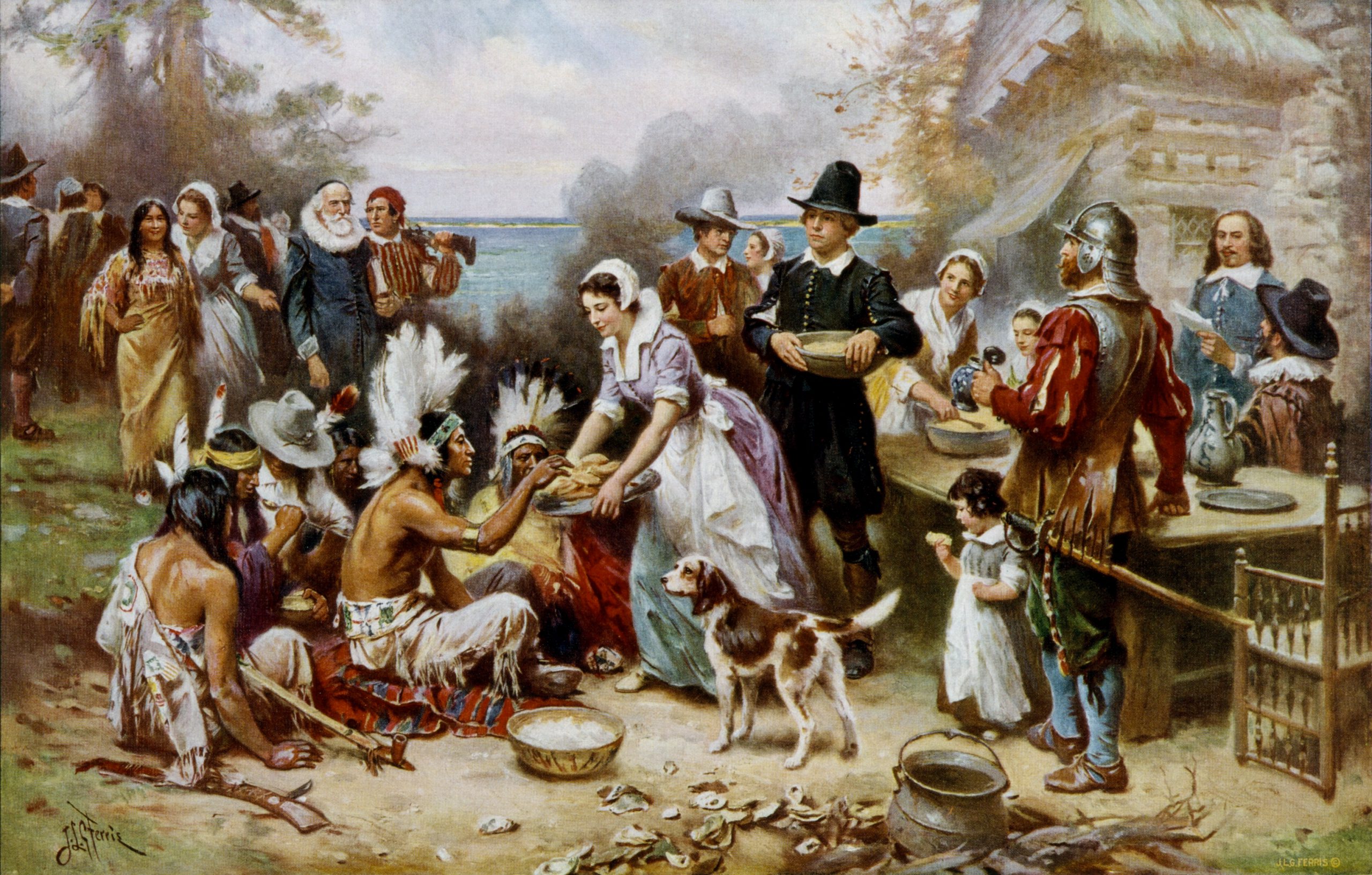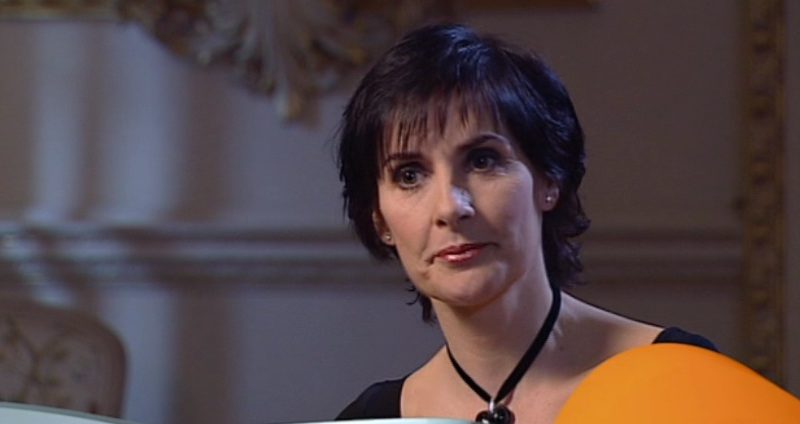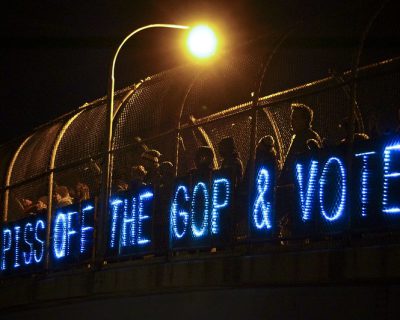What did you talk about at your Thanksgiving dinner?
A week after the celebration of the most American holiday, many people are still digesting dinner table conversations that might have wandered into current events. Whether they were contentious, or affirming, the Thanksgiving dinner table conversation as a reflection of our cultural moment has become a motif in popular culture. A survey of some of the most iconic enactments of the holiday meal in film and in television go some way toward putting last week’s conversations in context.
Unlike any other religious or secular American celebration, Thanksgiving offers a motif that resonates with nearly all American audiences, as Norman Rockwell shows in his iconic 1943 portrait of a family celebrating the holiday. The title of the painting is Freedom From Want; it is one in a series inspired by Franklin D. Roosevelt’s 1941 State of the Union address, Four Freedoms (freedom of speech, freedom of worship, freedom from want, freedom from fear), which he delivered shortly after the United States entered World War Two. Rockwell’s all-American family would, one hopes, look quite different today; but the propaganda potential is the same – almost everyone celebrates Thanksgiving, in similar ways, with similar cultural cues and breaks from the workweek.
Over the years, film directors have used Thanksgiving scenes as an instantly recognizable tableau for the foibles of the extended family. Many of those Thanksgiving scenes have become iconic — offering a peek into less-familiar narratives. They are also remarkably powerful reflections of the political climate of their time. Viewed years later, they offer salutary insights into whether and how things have changed.
In Avalon, the third of Barry Levinson’s semi-autobiographical Baltimore movies —of which Diner is perhaps the best known —Thanksgiving makes the director’s Jewish Baltimore deeply and undeniably American. Even for people who haven’t seen it, “You cut the turkey without me?!” has become one of the most-quoted lines about Thanksgiving.
Each Thanksgiving meal in Avalon marks the evolution and assimilation of the Jewish-immigrant Krichinsky family, presided over by the benevolent, mustachioed patriarch Sam Krichinsky (Armin Mueller-Stahl). As the children gather at their feet and listen raptly, the older generation — Sam, his brothers, their wives and offspring — regale them with oft-repeated stories about the old world, which the younger ones imbue with fresh ideas bred by the new world. The opening scene of Avalon shows Sam arriving in Baltimore as a young man, before World War One, a new immigrant landing on the Fourth of July amid the fireworks and fairy lights. The sense of splendor and 1950’s nostalgia are a constant in this deeply sentimental film; at times Levinson’s Americana schmaltz is almost too much to bear. Yet it reflects the sentiments of its time: the film was released in 1990, just as the Communist bloc was collapsing — a historical event that many (perhaps most) Americans viewed as a validation of their values. This feeling is reflected in Barry Levinson’s nostalgic film about growing up in post-war Baltimore as the grandson of Jewish immigrants from eastern Europe.
This American exuberance at the Thanksgiving table can be found in the films of two less likely candidates — Woody Allen’s Hannah and Her Sisters, and Spike Lee’s She’s Gotta Have It. Both films were released in 1986; they channel a Reagan-era sense of carefree consumption, the ability to recreate oneself, and endless second chances. Hannah and Her Sisters, one of Woody Allen’s best-known films, is framed and punctuated by three Thanksgiving meals. Given the director’s reputation for cynicism, “Hannah” is surprisingly optimistic, even as it explores the destructive potential of love and human frailty. The film begins with a Thanksgiving gathering at the sprawling Central Park West apartment of Hannah (Mia Farrow) and Elliot (Michael Caine). The camera take us through rooms that are suffused with warm light and happy children playing while clusters of adults drink, eat hors d’oeuvres, and converse. Hannah’s mother, a retired Broadway performer, sings while her husband accompanies her at the piano, and uniformed catering staff serve the food. Rather quickly, however, this scene of familial happiness morphs into something altogether different, with all the characters seemingly on the brink of ruinous heartbreak and professional failure. And yet, in tandem with the anguish over illicit love affairs, money problems, career frustration, and sibling rivalry, the city continues to sparkle and entice; the failures are minor and redeemed by success; death is defied; and most of the hearts not only survive intact, but seem to grow. The whimsy, humor, and celebration of New York City, with a closing Thanksgiving meal, full of heart and warmth, are what remain. Even Woody Allen and Dianne Wiest are happy at the end, which seems to make the film a veritable fairy tale.
She’s Gotta Have It, Spike Lee’s first (and arguably best) film, is a similarly overflowing package of whimsy and a sense of plenty. This includes its charmingly odd Thanksgiving meal. Nola, the female protagonist, is a free spirit whose enjoyment of love, sex, art, and the people around her are intoxicating, to both the characters and the viewers. For Thanksgiving dinner, the first she has ever cooked, Nola invites her three lovers — Jamie, Mars, and Greer. Over dinner the men joust for her affection, with their competitiveness extending to a post-dessert game of Scrabble. At the end of the evening each suitor is understandably reluctant to leave, hoping he will be the one Nola chooses to spend the night with her. The final scene is a beautiful overhead composition of Nola and Jamie lying in one another’s arms on her bed, with Mars and Greer hanging on nearby as the music plays — until they finally give up and leave. Like Hannah and Her Sisters, the film feels suffused with a late-1980’s American intoxication with itself – even when it’s pushing the margins or making them visible. Spike Lee provides a portrait of black Americans that doesn’t use white America as a reference point. This world exists regardless of whether or not white people are aware of it or understand it; just as Nola offers herself without apology or excuse, so does Spike Lee present black America.
While less celebratory Thanksgiving films exist — Parker Posey offers two examples of unhappy Thanksgiving gatherings in her cult classics The Day Trippers and House of Yes — television has more space to dig into broader conversations. The Thanksgiving episodes in some older television series feel shockingly political in a way that seems inconceivable today. In a 1994 episode of Roseanne, abortion is the predominant theme: four generations of women sit at the holiday table sharing their views and experiences, with Roseanne expressing views that are stridently pro-choice. When she and Dan discover their unborn child may not be healthy, however, Roseanne suddenly realizes she might not be so certain about her own choice. It is a remarkably thoughtful conversation —one of many salutary episodes in a series that gave white working-class Americans a nuanced, complex voice.
That other avatar of the white working man, Archie Bunker (Carroll O’Connor), famously served as a foil for the preoccupations of the 1970s. In the 1974 Thanksgiving episode of All In The Family, he and Edith are invited to the new home of their daughter Gloria, and son-in-law Mike (a.k.a Meathead). Since Gloria is pregnant, the subject of whether or not the child will be raised with religion arises, with Archie and Edith expressing hurt and dismay that their grandson might be raised a liberal atheist.
All in the Family is one of the few shows premised entirely on the culture wars of the 1970s; viewed today, it holds up a sobering mirror to our contemporary political moment — i.e., we’ve regressed to a place where those inter-generational conflicts of 45 years ago now feel acutely relevant. Emily Nussbaum, The New Yorker’s television critic, adds an additional insight in her brilliant essay about All in the Family, titled “The Great Divide: Norman Lear, Archie Bunker, and the Rise of the Bad Fan.” The show, observes Nussbaum, attracted many “bad fans” who watched because they identified with Archie Bunker and his bigoted views. He was meant to be the old racist uncle at the Thanksgiving dinner table, an anachronistic buffoon, but many of his fans loved him because they shared his worldview. This is one of the dangers posed by using anti-heroes to explode cultural stereotypes and advance conversations.
The new canvas created by the so-called Golden Age of television has endowed the Thanksgiving episode with even greater potential. Friday Night Lights, one of the best twenty-first century portraits of very key elements of American culture, provided a perfectly fraught Thanksgiving episode in 2010, very much under the shadow of the culture wars and the polarized national debate on abortion. Tami Taylor, one of the main characters, is a principal of a high school in this a small, conservative, Texas town of churchgoers. After she is discovered to have advised a pregnant student to explore her options, guiding her with empathy and a total lack of judgment, Tami is publicly criticized and nearly fired from her job. At Thanksgiving dinner she is in the midst of dealing with the fallout from this incident, which makes the holiday a brief and not completely relaxed respite. While the subject itself is not discussed at the dinner table, her anxiety over it permeates the evening and she is visibly distracted. This Thanksgiving dinner, as is so often the case in real life, represents a short respite from the battles of the workweek. The next day she is essentially told she is fired, and so decides to leave and work as a counselor at another school, where she is needed and wanted. When she returns home, her husband and daughters are putting up the Christmas lights, in a perfect exhalation and sense of relief.
One of the most touching Thanksgiving episodes in recent years is Denise’s coming out story in a 2017 episode of Master of None, Aziz Ansari’s scripted show on Netflix. The show ran for two seasons, took on some very big issues with humor and insight that showed one can be woke and sensitive and remain funny; its demise is a real loss — it was a cathartic corrective to the Trump presidency, an advancement of so many important conversations. The Thanksgiving episode shows Denise and Dev, who are childhood friends, at the former’s home over several holiday celebrations, starting when they are about 6 years old. Successive scenes in the episode show the same tableau when they are 12 and 16 years old; it then jumps forward to 2015, 2016, and 2017. Dev is the only male, and the only non African-American at these Thanksgiving tables, over which Denise’s single mother, aunt and grandmother preside. It is a beautiful extended family that gradually, by the very end, grows to include Denise’s partner Michelle. The path there is lovingly charted – and the specific challenges of coming out as gay in the African American community are explored. The “non-conventional” family debunks the notion that they lack anything a traditional nuclear family might offer.
It seems odd that the cultural currency of Thanksgiving is underestimated or unrecognized– it has as captive an audience as is still possible and offers a trope that is so universally familiar. It also sets lower expectations for denouement, as Christmas might, which makes it a better canvas for experimentation or unintended projections. This is why Thanksgiving, the ultimate American holiday, has often been the best means for getting a real sense of the country’s political pulse via popular culture. We are all tuned in, and not because we are preoccupied with impeachment hearings. We just happen to be watching.



